Honda CBR 1000RR Engine
| Claiming 172 crank horsepower @ 10,500 in standard 49 state-trim, the power plant has been totally redesigned with a new bore and stroke (75mm / 56.5mm).
This 998cc configuration allows for a narrow and compact design with more vertical cylinder positioning, stacked transmission with removable cassette, a relocated right side oil
filter and starter drive. Engineers were able to shorten the power plant 40mm. The theme here is "Mass Centralization" with Honda's critical focus accounting for exactly
where all weight is placed. |
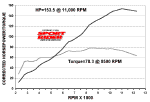
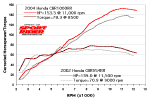
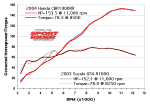
|
From Honda's 2004 press material:
|
|
Tracing the Road to World-Class Power
The CBR(r)1000RR boasts a truly world-class powerplant, an all-new liquid-cooled 998cc inline four-cylinder engine carefully designed to also enhance handling. Begin by
comparing the overall silhouette of the new 1000 and the CBR954RR, and immediately you can see there's no comparison; the CBR1000RR boasts significantly smaller, more compact
dimensions. There are blatantly obvious changes, such as relocating the oil filter away from the front of the engine to save space. And high-tech tricks such as designing a new,
slimmer and lighter ACG with neodymium magnets to help keep case width especially narrow. But Honda's commitment to mass centralization in this new-generation Superbike permeates
through and through every cubic centimeter of the engine.
For example, at the very heart of the CBR1000RR, we find a compact 75mm bore size contributing significantly to the engine's narrow proportions. Engine stroke measures 56.5mm--a
combination also selected specifically for its ability to generate loads of torque along with plenty of top-end horsepower.
|
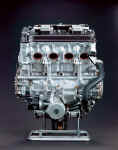
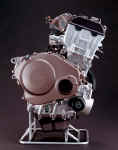
|
Making it Light
Strong and durable forged aluminum slipper pistons coupled to nutless connecting rods feature less reciprocating mass to produce a quicker-revving engine. In addition, the
piston skirts have been impregnated with molybdenum to create a friction-reducing surface, an innovative treatment both tougher and longer lasting than the LUB coating Honda(r)
used previously. More than a surface coating, this process literally shoots particles of pure, low-friction molybdenum into the skirts of the piston with such high force and
temperature they become embedded into the surface of the aluminum with a chemical reaction that bonds the material together.
These pistons run through aluminum composite cylinder sleeves high-pressure formed from sintered aluminum powder impregnated with ceramic and graphite for improved wear
resistance and superior heat dissipation. And for the first time in a street bike engine design, the CBR1000RR cylinder block incorporates a semi-closed deck that positively
secures the tops of the cylinder bores to the outer walls of the block with cast-in bridges for increased rigidity and consistency in cylinder bore shape under all conditions.
To further reduce reciprocating mass, the CBR1000RR features nutless connecting rods with end caps held in place by bolts that thread directly into tapped holes in the rods.
This design shaves approximately 50 grams out of these critical engine components to reduce mechanical loads and also improve engine response and acceleration.
The DOHC cylinder head employs four valves per cylinder, 29mm intake and 24mm exhaust. These valve head diameters match those from the 954, but the stems of the new valves have
been slimmed from 4.5mm to 4.0mm for lighter weight and reduced friction. This weight reduction also allows the use of lighter valve springs, for quick and precise valve actuation.
Compared to the 954, included valve angles are slightly flatter (23.5 degrees vs. 25.0) to open up the combustion chamber for more efficient burning, and intake ports were raised
to create a straighter path for the incoming fuel charge. The CBR1000RR features shim-under-bucket valve adjustment for high-rpm durability; engine redline is set at 11,650 rpm. To
keep the engine spinning smoothly even at such elevated speeds, the RR features a light but efficient balancer shaft mounted close to the crankshaft to maximize mass
centralization.
|
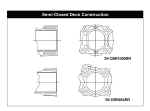
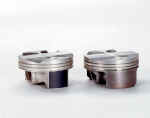
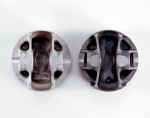
|
Programmed Dual Stage Fuel Injection
To feed this big engine, Honda engineers lifted another page from the RC211V formula and installed Programmed Dual Stage Fuel Injection (PGM-DSFI). As its name implies, DSFI
employs a pair of injectors for each cylinder.
This dual-injector system eliminates a significant compromise inherent in older single-injector setups. In the past, if low-end engine response was desired, the fuel injectors were
mounted close to the intake ports. On the other hand, if maximum power was desired, the injectors had to be mounted father away from the intakes--a direct conflict with the
practice of positioning the injectors for best response. Honda's engineers resolved the compromise by employing dual injectors to meet both objectives.
First, a set of all-new Denso injectors has been mounted in the venturis of the large 44mm machined aluminum throttle bodies. An entirely new manufacturing process endows these
fourth-generation injectors with a radial array of 12 holes that produce a wider, more diffused output. As a result, this more finely atomized spray covers a wider area and mixes
20 percent more efficiently with the intake air, which results in more efficient combustion. In addition, new, dramatically lighter needle bearings allow the injectors to respond
to electric signals 30 percent faster than the previous generation--an amazingly short response time of 1/1000th second. In addition, these new-generation injector bodies also
weigh 25 percent less than the previous units.
To ensure a constant flow of fuel at higher engine speeds to produce maximum power, the second set of 12-hole injectors rests in the top of the air box, directly above the velocity
stacks of each throttle body. This second bank of injectors come into play at engine speeds of 5500 rpm and higher.
|


|
As these showerhead-style injectors spray a finely atomized fuel charge into the intake areas, this blast cools the air/fuel mixture, thereby creating a
denser charge that produces more power. Together, these dual injectors solve the classic injector dilemma, delivering stellar throttle response while also pumping out exemplary
top-end power.
A sophisticated 32-bit Electronic Control Unit with dual 3-D injection maps for each cylinder manages the fuel injection system, and also handles the ignition and emissions
systems. In addition, the ECU incorporates the control systems for the ram-air intake system, exhaust valve and the CBR1000RR's innovative electrohydraulic steering damper.
Amazingly enough, for all of its high-powered processing capability, this new-generation ECU is small enough to fit in the palm of your hand.
Cold air intake for the CBR1000RR is controlled by a two-stage system, which includes the main ram-air duct located below the bottom triple clamp and above the new large-capacity
radiator, plus a smaller dual-intake sub-duct system. At low engine speeds, air flows into the sub-duct system through two doors, one located on each side of the larger intake
tract. At higher engine speeds, a vacuum-operated system closes the doors to the sub-duct system while simultaneously opening a door to the main ram-air duct, thereby creating a
high-pressure flow of cold, dense air for a dramatic increase in midrange and high-speed power. New high-flow cylindrical air filter elements reside within the 8.35-liter air box,
which is hidden away under the front portion of the faux fuel tank cover.
|
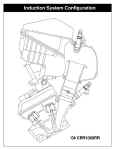
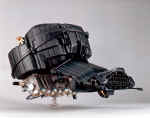
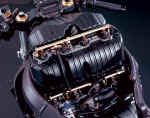
|
Cassette Gearbox
Another industry-leading feature gracing the CBR1000RR takes its roots squarely from the racetrack: a cassette-type close-ratio six-speed transmission. Thanks to the easy access
afforded by a cassette gearbox, the 1000RR will definitely deliver an advantage to racers who need to match gearing to different racetracks and under varying conditions. To gain
access to the gearbox you simply remove the right side crankcase cover, and the clutch assembly, shift forks and drum can be removed as an entire assembly. To cope with its
additional power, the clutch diameter now measures 140mm, up from 125mm in the 954, and clutch actuation now occurs through a hydraulic system.
With an eye fixed firmly on the racetrack, Honda's engineers designed a radiator for the CBR1000RR that dwarfs the unit affixed to the 954, boasting 211 square inches compared to
127 square inches. This increased size raises cooling capacity 41.5 percent, from 26kW to 36.8kW, and the fan size has also grown from 171mm in diameter to 191mm. Whether you find
yourself on the starting line at your local racetrack or stuck in stop-and-go city traffic, you'll be sure to appreciate this extra cooling capacity.
How was it possible to incorporate such a large radiator? Again, it was part of a holistic design from the very beginning. Setting the cylinder block in a relatively upright
position creates more room up front, and that space was enhanced by repositioning the oil filter from its familiar up-front position to a spot on the right side of the engine--a
design elegant in its simplicity.
Another example of racetrack-oriented engineering can be found in the lightweight magnesium oil pan. By employing special high-temperature magnesium in place of aluminum, Honda's
engineers could save a full 375 grams. This special material also provides better structural resistance to deformation at extremely high temperatures, for more reliable sealing. As
an added weight-saving measure, the 1000RR's head cover is also made of magnesium.
|
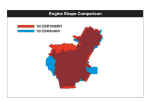
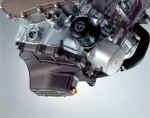
|
Exhaust Tuning
On the exhaust side of the engine, a brand-new servo-controlled system actuates a next-generation valve located within the four-into-two-into-one steel and titanium center-up
exhaust system. This cable-actuated stainless steel butterfly valve resides just downstream of the collector and is operated by a servomotor that receives control signals from the
central ECU. As a bonus, this new system is a whopping 770 grams lighter than the system used in the CBR954RR.
By tuning exhaust pulses and back-pressure at specific engine speeds, this system significantly improves power output and engine response at all engine speeds without the added
noise. As this tunable exhaust system works in conjunction with the Dual Stage Fuel Injection system--with air flow managed by a new ram-air setup--the CBR1000RR power plant has
become a model of engine tuning flexibility. As a result, this world-class machine does it all: it churns out massive amounts of low-end torque, packs a wallop in the midrange, and
then caps it all off with genuine Superbike-class top-end power. |
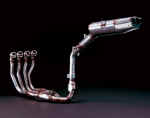
|
|